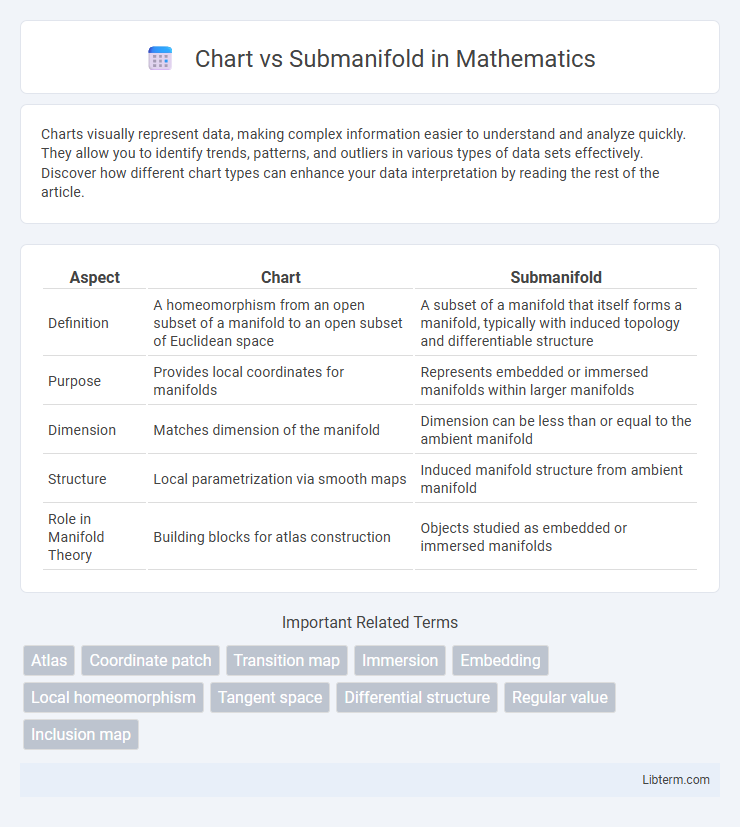Charts visually represent data, making complex information easier to understand and analyze quickly. They allow you to identify trends, patterns, and outliers in various types of data sets effectively. Discover how different chart types can enhance your data interpretation by reading the rest of the article.
Table of Comparison
| Aspect | Chart | Submanifold |
|---|---|---|
| Definition | A homeomorphism from an open subset of a manifold to an open subset of Euclidean space | A subset of a manifold that itself forms a manifold, typically with induced topology and differentiable structure |
| Purpose | Provides local coordinates for manifolds | Represents embedded or immersed manifolds within larger manifolds |
| Dimension | Matches dimension of the manifold | Dimension can be less than or equal to the ambient manifold |
| Structure | Local parametrization via smooth maps | Induced manifold structure from ambient manifold |
| Role in Manifold Theory | Building blocks for atlas construction | Objects studied as embedded or immersed manifolds |
Introduction to Charts and Submanifolds
Charts in differential geometry provide local coordinate systems that map open subsets of a manifold to Euclidean space, enabling the study of smooth structures. Submanifolds are subsets of manifolds that themselves carry a manifold structure, often characterized by embeddings or immersions compatible with the ambient manifold's topology and differentiable structure. Understanding charts lays the foundation for analyzing submanifolds, as they facilitate local descriptions essential for definitions and proofs involving smooth embeddings and restrictions.
Fundamental Concepts in Differential Geometry
A chart in differential geometry provides a local coordinate system mapping an open subset of a manifold to Euclidean space, enabling precise calculations and analysis. A submanifold is a subset of a manifold that itself carries a manifold structure compatible with the ambient manifold, often characterized by immersion or embedding properties. Understanding the interaction between charts and submanifolds is key for studying smooth maps, tangents, and differential structures within higher-dimensional spaces.
What is a Chart?
A chart in differential geometry is a homeomorphism from an open subset of a manifold to an open subset of Euclidean space, providing a coordinate system for the manifold locally. It enables the representation of abstract manifolds through real coordinate tuples, facilitating analysis and calculations. Charts are essential components of an atlas, which collectively cover the entire manifold for smooth structure definitions.
Defining Submanifolds
Defining submanifolds involves identifying subsets of manifolds that locally resemble Euclidean space and inherit a compatible smooth structure from the ambient manifold. Charts for submanifolds are constructed by restricting the domain of charts from the parent manifold, ensuring smooth embeddings and preserving differentiability. This approach guarantees that submanifolds maintain manifold properties while facilitating analysis through adapted coordinate systems.
Chart vs Submanifold: Key Distinctions
A chart is a homeomorphic mapping from an open subset of a manifold to an open subset of Euclidean space, used to provide local coordinates and facilitate analysis on the manifold. In contrast, a submanifold is a subset of a manifold that itself forms a manifold, often defined by embedding or immersion, inheriting a manifold structure compatible with the ambient manifold. Key distinctions include that charts are functions defining local parameterizations, while submanifolds are geometric objects embedded within manifolds, highlighting local coordinate systems versus intrinsic manifold subsets.
Role of Charts in Describing Submanifolds
Charts play a crucial role in describing submanifolds by providing local parametrizations that map open subsets of Euclidean space bijectively onto neighborhoods in the submanifold. These mappings allow the submanifold to inherit a differentiable structure from the ambient manifold, facilitating analysis using coordinate-based techniques. By using compatible charts, one can define smooth transition functions, ensuring the submanifold maintains consistency within the larger manifold's topology and geometry.
Examples Illustrating Charts and Submanifolds
Charts in differential geometry provide local coordinate systems that map open subsets of a manifold to Euclidean space, such as the stereographic projection of a sphere onto the plane. Submanifolds are subsets of manifolds that themselves possess manifold structure, exemplified by a circle embedded in the plane or the torus embedded in three-dimensional space. These examples illustrate how charts offer local parameterizations, while submanifolds demonstrate embedded structures with inherited dimensionality and smoothness properties.
Applications in Geometry and Physics
Charts provide local coordinate systems on manifolds essential for defining smooth structures, enabling precise calculations in differential geometry and general relativity. Submanifolds represent subsets of manifolds that retain manifold properties, crucial for studying embedded geometries and constraints within physical models like branes in string theory. Both concepts facilitate the analysis of curvature, topology, and dynamical systems in geometric formulations of physical phenomena.
Common Misconceptions and Clarifications
Charts and submanifolds are often confused due to their overlapping roles in differential geometry, but a chart is a homeomorphism from an open set of a manifold to an open set in Euclidean space, serving as a coordinate system, while a submanifold is a subset of a manifold that itself carries a manifold structure compatible with the ambient space. A common misconception is that every chart coordinates a submanifold, whereas charts can describe the entire manifold without necessarily relating to any submanifold. Clarification arises by emphasizing that submanifolds require the immersion or embedding properties, while charts only need local homeomorphisms and differentiability.
Summary and Further Reading
A chart provides a local coordinate system mapping an open subset of a manifold to Euclidean space, enabling analysis and computations. A submanifold is a subset of a manifold that is itself a manifold, often defined by the restriction of charts or as the image of an embedding. For in-depth understanding, consult sources such as Lee's "Introduction to Smooth Manifolds" and Spivak's "Differential Geometry," which offer comprehensive treatments of charts, submanifolds, and their applications.
Chart Infographic

 libterm.com
libterm.com